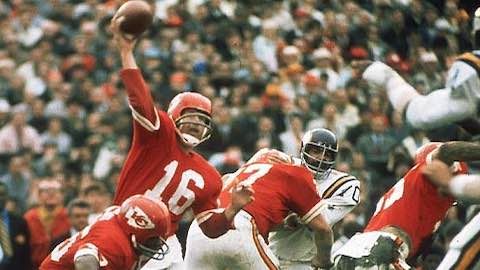
QUARTERBACK GUIDED CHIEFS TO MAJOR UPSET OF VIKINGS IN SUPER BOWL IV
It was January 10, 1970, on an unusually cold day in New Orleans. The Super Bowl, in those days, still paired the establishment league, the NFL, and the upstart American Football League, and, as fate would have it, my family lived in Houston at the time.
An AFL city.
Brash, charismatic quarterback Joe Namath had already directed the New York Jets, a 17.5-point underdog, to an improbable 16-7 victory over the Baltimore Colts in Super Bowl III at the Orange Bowl in Miami.
One year later, the NFL had another heavy favorite in the Super Bowl. Joe Kapp and the Minnesota Vikings were favored by anywhere from 12.5 to 13.5 points on that January day in New Orleans, and 50-plus years ago, the Super Bowl was actually played in the afternoon.
Not in prime time.
Pro football was still evolving in those days, and a merger between the two leagues was on the horizon. But the professional game needed a shot in the arm, and it certainly got one on that chilly January day at Tulane Stadium in New Orleans.
Joe Kapp, a rough-around-the-edges quarterback, and an exceptional defense took the Vikings through the NFL playoffs. In the championship game, Bud Grant’s Vikings whipped the Cleveland Browns, winning 27-7 at Metropolitan Stadium in Bloomington, Minnesota.
Meanwhile, in Kansas City, understated quarterback Len Dawson was leading the Chiefs to their second Super Bowl berth in four years. The Chiefs were a complete team, with future Pro Football Hall of Fame defenders in linebackers Bobby Bell and Willie Lanier, and defensive tackles Buck Buchanan and Curley Culp, who also are immortalized in Canton.
The Chiefs also had two defensive backs now in the Pro Football Hall of Fame, cornerback Emmitt Thomas and safety Johnny Robinson.
Offensively, however, they were still a little bit of a mystery.
Until Len Dawson directed the Chiefs to an impressive 23-9 victory over Joe Kapp and the Vikings. Hank Stram’s Kansas City squad took control in the first half and kind of coasted down the stretch, and Bud Grant’s Vikings were not a team built to overcome big deficits.
Again, pro football was kind of evolving in those days.
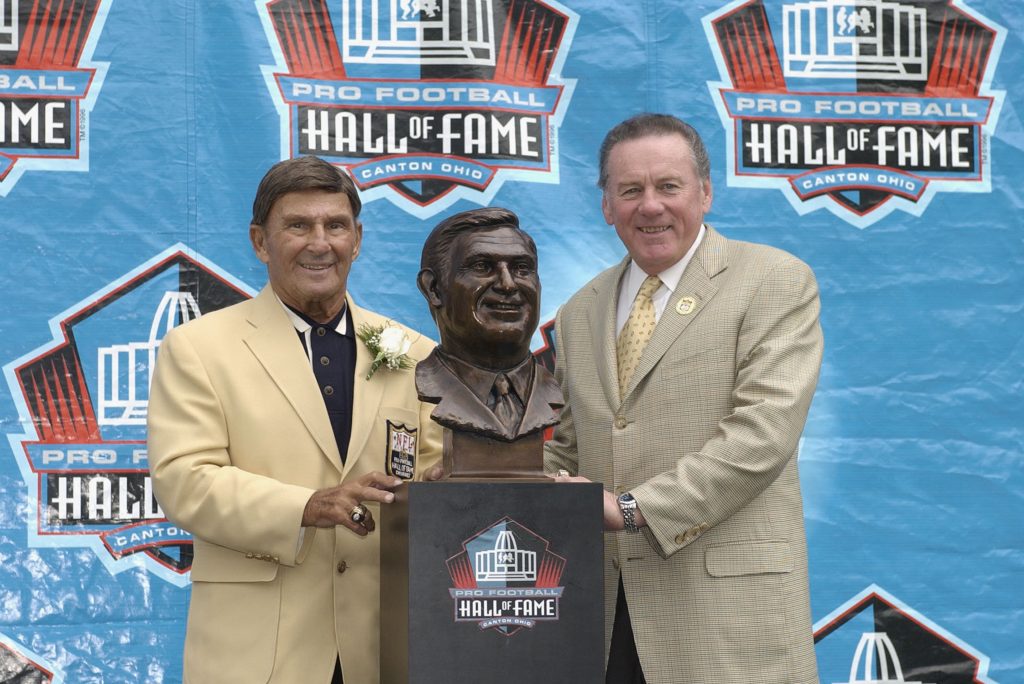
AT PRO FOOTBALL HALL OF FAME CEREMONIES IN 2003.
Dawson, who died on Wednesday at the age of 87, became the central figure of that football game, several days before it even kicked off in New Orleans.
Dawson had been linked to an IRS investigation of a man named Donald J. Dawson, who was not related to the Chiefs quarterback. Some sloppy reporting led to all sorts of innuendo and rumors about Len Dawson’s availability, going into the game, and I remember how it dominated the narrative, as a 13-year-old football fan in Houston, Texas.
Turns out Lenny Dawson did absolutely nothing untoward, or illegal, as far as gambling. He even agreed to take a lie-detector test. But Dawson was nothing short of magnificent in that Super Bowl game, completing 12 of 17 passes for 142 yards and a touchdown. The Chiefs led 16-0 at halftime and Joe Kapp and the Vikings were simply overmatched, losing 23-7.
The AFL was legit. And Len Dawson, like Joe Namath before him, had a lot to do with that.
There’s only one Broadway Joe, of course, but you can make the argument that Leonard Ray Dawson was a pretty unique cat himself. He played high school football in Alliance, Ohio, before moving onto Purdue University, where Hank Stram was an assistant coach.
Stram and Dawson joined forces again in Kansas City, and the Chiefs played in two of the first four Super Bowls. Vince Lombardi’s Green Bay Packers overpowered the Chiefs 35-10 in the first Super Bowl, played at the Rose Bowl in Pasadena, California. Three years later, the Super Bowl was played in New Orleans for the first time, and they’ve played the Super Bowl in the Crescent City 10 times, second only to Miami, Florida, with 11.
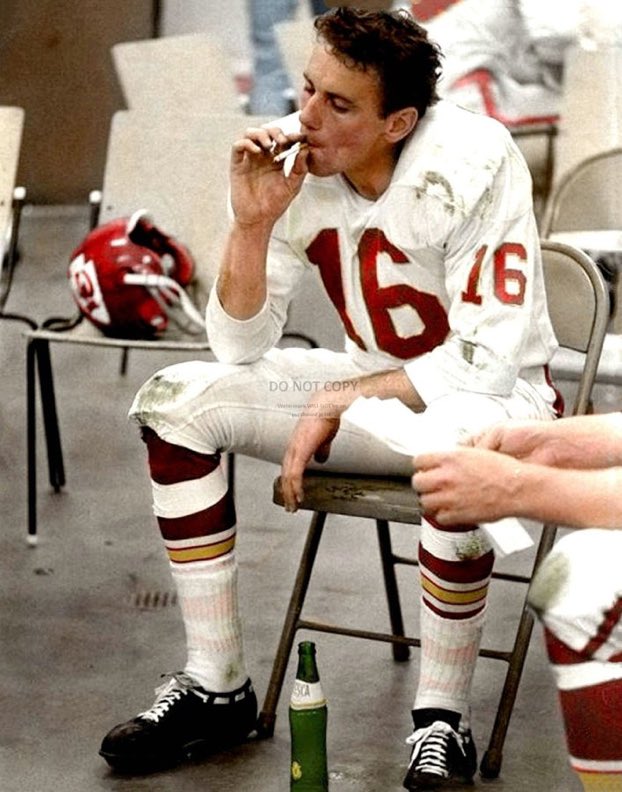
VINCE LOMBARDI’S PACKERS CRUSHED THE CHIEFS 35-10.
Len Dawson was photographed smoking a cigarette, in the locker room, at halftime of that first Super Bowl game. He’s got a bottle of Fresca at his feet and he seems to be in deep thought, with that cigarette hanging out of his mouth.
Three years later, Len Dawson and the Kansas City Chiefs were the toast of pro football. They were one of the first professional teams to scout players from Historically Black Colleges and Universities, also known as HBCU schools. Middle linebacker Willie Lanier played college ball at Morgan State. Buck Buchanan came to the Chiefs from Grambling. Star wide receiver Otis Taylor hailed from Prairie View A&M.
And Len Dawson was a Cool Hand Luke in that second Super Bowl, that 23-7 victory over “The Purple People Eaters” and the Minnesota Vikings. He was adept at avoiding the pass rush in the pocket, and he was efficient in running Hank Stram’s multi-look offense. The Chiefs would huddle in that unusual formation, with Dawson looking into the eyes of his teammates, in two rows of five players — linemen in the back, natch — before stepping up to the line of scrimmage.
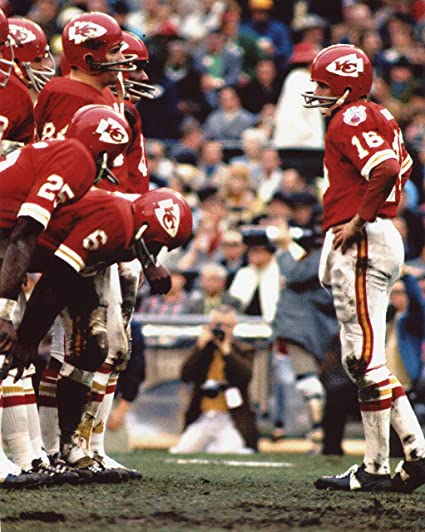
UNUSUAL FORMATION FOR THEIR HUDDLES.
(On defense, it was middle linebacker Willie Lanier who called the plays. One of my childhood heroes, after my father, the late John Mashek, told me about Lanier’s back story.)
Dawson knocked around the NFL for five seasons with the wretched Pittsburgh Steelers (1957-59) and Cleveland Browns (1960-61). In 1962, with the birth of the American Football League, Dawson moved on to play for the AFL’s Dallas Texans. The Texans were the AFL champions that year, beating the Houston Oilers 20-17 in two overtimes.
One year later, the Texans became the Kansas City Chiefs.
And the Chiefs quickly became part of Kansas City, and vice versa.
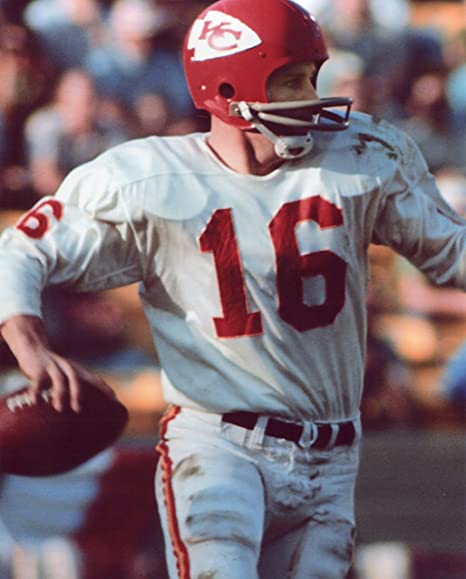
WHO PLAYED 19 YEARS IN PRO FOOTBALL.
Dawson played a total of 19 seasons in pro football, and he became a Kansas City sportscaster in the final years of his career. Dawson went on to become a mainstay on HBO’s “Inside the NFL” while continuing to work in TV news in his adopted hometown of Kansas City.
Dawson was selected to the Pro Football Hall of Fame in 1987, and he was introduced at the ceremonies in Canton, Ohio, by his Chiefs head coach, the colorful Hank Stram.
(Dawson returned the favor in 2003, two years or so before Stram’s death at 82.)
Len Dawson was an efficient player, who led the AFL in passing six times. He played with the Chiefs through the 1975 season, four years after the merger, and he stayed around the game his entire life. An All-American at Purdue, he went into broadcasting and was a true pro in that endeavor, too.
Rest easy, Mr. Dawson. A class act, all the way.

